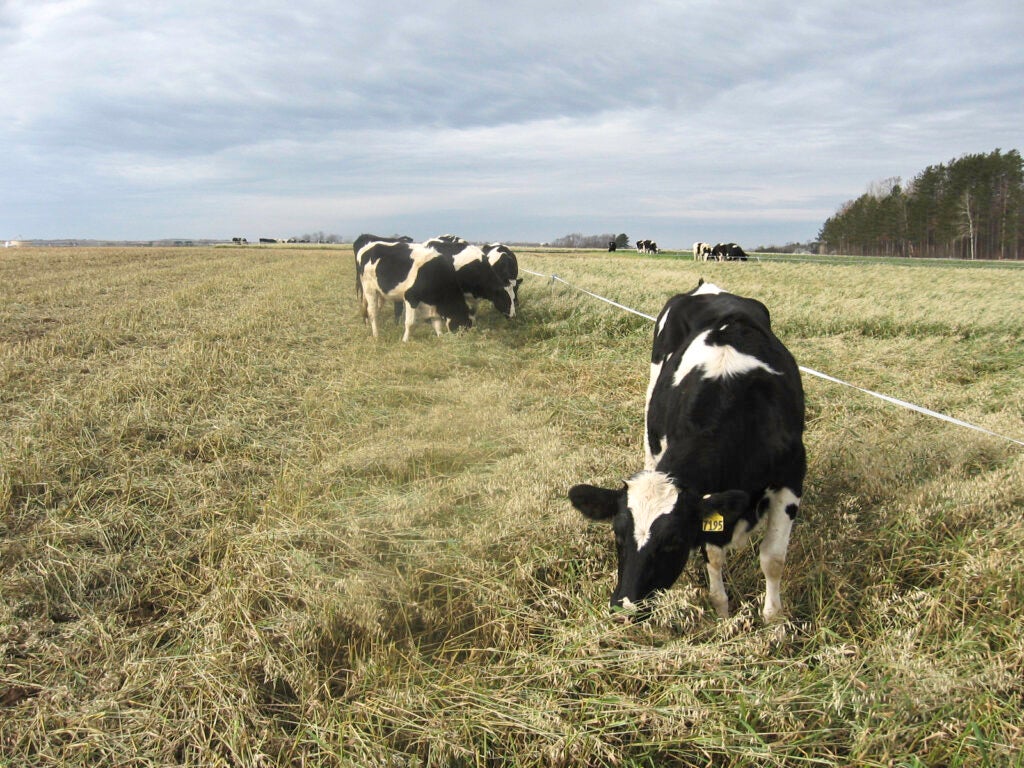Dairy and beef producers are feeling the strain of heat waves — and so are their animals. Longer, hotter summers are making it harder for cows to stay healthy and productive. Heat stress lowers milk yields, weakens cows’ immune systems and can even threaten fertility.
For farmers, the impacts go beyond animal health: heat stress reduces milk yields and fertility in cows, which translates directly into financial losses from lower production and higher management costs. Lower productivity also increases the methane intensity of any milk or meat produced.
But across the world, producers, veterinarians and nutritionists are responding with new tools and time-tested strategies to help livestock cope. These solutions matter not only for animal health, but for food security, rural livelihoods and climate resilience.
How does extreme heat impact cows?
When cows are exposed to high temperatures and humidity, they struggle to stay cool. Unlike humans, cows cannot sweat effectively, and their natural cooling behaviors, like panting or standing more, aren’t as effective in extreme conditions where temperatures are hotter or prolonged. A cow’s normal body temperature is about 102°F, so even small increases can push them into dangerous territory. Scientists use the Temperature-Humidity Index (THI) to measure when conditions become stressful for livestock.
It’s important to keep the Temperature-Humidity Index (THI) below a critical threshold, because when cows overheat — a condition known as “heat stress” — it leads to lower feed intake, reduced milk production, and changes in milk quality. It also impairs fertility and weakens the immune system, leaving cows more vulnerable to illness. These effects can linger even after temperatures drop.
In the United States, dairy producers lose an estimated $1 to $2.5 billion each year due to heat-related impacts, with small and mid-sized farms often hit hardest.
Why heat stress in livestock looks different around the world
Heat stress doesn’t play out the same way everywhere. In high-income countries like the U.S., dairy and beef operations often rely on high-producing breeds of cattle, like Holstein cows or Angus cattle, that eat more, generate more internal heat and have thicker coats. These traits make them more susceptible to warmer temperatures. These farms might use fans or misters to help keep cows comfortable.
In regions with hotter climates, livestock breeds are often better adapted to heat stress but may have lower productivity. For example, Zebu cattle have lower metabolic rates and lighter coats. However, farmers in these areas may face additional challenges, such as limited access to water, veterinary care or infrastructure to protect animals from rising temperatures.
That’s why there’s no one-size-fits-all solution. Helping farmers adapt means supporting strategies that work in local conditions and across herd sizes — solutions are going to look drastically different for a herd of 1,000 cows versus six or eight cows. From investing in low-cost shade structures to breeding animals for both heat tolerance and productivity, all farmers need support for cooling options that work on their farm.
What are farmers doing to mitigate heat stress?
Farmers are adjusting how they feed, house and manage animals to cope with rising temperatures. Some are installing shade structures, fans or sprinklers to help cool animals. Others are changing feeding schedules and shifting to the evening when temperatures are lower.
Adjustments to animal diets can help reduce digestive problems linked to heat, such as leaky gut. Farmers are also moving grazing and handling to cooler hours and adjusting how many animals are kept in a space to avoid crowding.
Many of these strategies are effective, but that doesn’t mean that they’re equally accessible. Smaller farms in particular may not have the resources to invest in infrastructure or to hire specialists. We need policy, financing and research to ensure farmers can adopt appropriate heat mitigation practices before the next heatwave hits.
Building a climate-resilient future for livestock and farmers
The way we care for livestock in a changing climate will shape the future of food. Heat stress is already making it harder for farmers to stay afloat and for some communities to access reliable, affordable nutrition. Consumers may also feel the effects, as prolonged heatwaves can reduce supply and drive up prices at the grocery store.
Supporting heat-resilient livestock systems is about ensuring a stable food supply, protecting rural economies and helping communities adapt to a hotter world. We all have a stake in helping ensure farmers have the tools they need to weather what’s coming.










